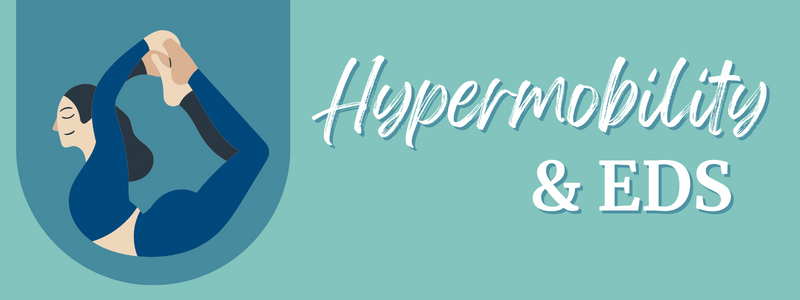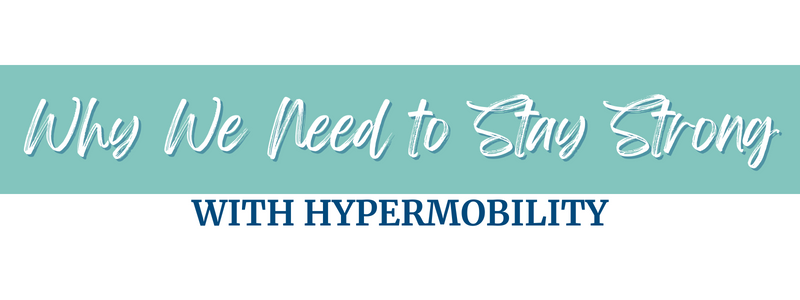
Are you naturally flexible?
Ever wonder if your extra flexibility is good or bad for your joints?
You might be considered hypermobile
Find answers to "what is hypermobility, EDS and what your can do to protect your joints"
Hypermobility is a condition in which a person’s joints move beyond the normal range of motion. People who are hypermobile tend to have the ability to move their limbs beyond the limits of what most people can move. Hypermobility is not an all or none condition, but instead it is a range with some people being just slightly more mobile, while others are very very hypermobile. It is not fully understood by the medical community, however, it can be caused by a number of factors including genetics or connective tissue disorders.

One connective tissue disorder that can cause hypermobility is, Ehlers-Danlos syndrome (EDS). EDS is a rare genetic condition that affects the body’s connective tissues, including the skin, joints, and blood vessels. Hypermobility in EDS can affect nearly every joint from your large hip joint, to your small finger joint. The complications of joint hypermobility in EDS can be significant. For one, people with EDS are at a higher risk of joint dislocations and subluxations (partial dislocations). These can be extremely painful and can lead to further joint damage if left untreated. Additionally joint hypermobility can contribute of chronic pain and fatigue, as the muscles surrounding the joints have to work harder to keep them stable
With EDS and hypermobile we often use the Beighton score for hypermobility to easily grade the amount of flexibility. The therapist will observe the range of motion in the elbows, knees, thumb, pinky and touching the floor with knees straight. We often see individuals with hypermobility can straighten their knees and elbows past 180 degrees, they can easily bend forward and touch the ground with their knees straight, their pinky finger can bend backwards to 90 degrees and their thumb can bend to touch their forearm. The Beighton score is a popular series of tests which can easily grade and give an objection score to the amount of hypermobility.
Hypermobility- EDS- Scoliosis
Hypermobility and Scoliosis are two musculoskeletal conditions that can often coexist. It is unclear why we often see these conditions together. One way that they could be related is through the muscles and ligaments surrounding the spine. In people with hypermobility, these muscles and ligaments may be looser than normal, which can contribute to an increased risk of scoliosis. Additionally, hypermobility can make it more difficult for those muscles and ligaments to hold the spine in a straight position, which can make a scoliosis cure worse.
Another way that hypermobility and scoliosis can be related is through a condition called connective tissue disorder. The connective tissue is responsible for providing support and structure to our body, and people with hypermobility often have weaker connective tissue. this can lead to an increased risk of scoliosis, as the spine may not have the necessary support to maintain a straight position.

Although it seems like many of us stretch daily and are trying to become more flexible, for hypermobile people too much flexibility lead to problems. Bones and joints that are not properly secured and held together can create rubbing and impingement. This can cause joint spaces to become inflamed and can ultimately lead to compensation which could lead to pain and additional complications.
Hypermobility can also cause muscles around joints to become overused and prone to injuries. For those with hypermobility exercising can have a unique set of challenges. The lack of stability in the joints means that the muscles must work harder at times to provide a stable joint. If we think about the knee for example. Typically a knee can flex (bend) about 135 degrees and extend (straighten) to 0 degrees. A hypermobile knee can move much easier into end range flexion and past neutral into extension. The concern is if the knee goes too much past neutral extension, it can damage the ligaments. To prevent this damage, the muscles all around the knee must work overtime to hold the joint stable. These muscles around the joints can be overused and overworked which create fatigue, overuse injuries and generalized pain. Strengthening can be challenging due to the lack of control and stability in hypermobile joints. Therefore, it is important to use controlled and specific movements that protect joints and muscles. People with EDS may also develop other joint related conditions such as arthritis and tendinitis. These conditions can exacerbate join pain and lead to joint stiffness and limited mobility.
Strength training is a vital activity for those individuals with hypermobility but it is imperative to train in a safe way that will improve conditions rather than damage. Let’s discuss a little more about the problems with hypermobility and healthy ways to combat them.

The stronger we keep the muscles surrounding the joints the more stable the joints become and therefore the more we reduce the risk of injury. This is especially important in our spines. Due to the excess motion that hypermobility allows, it is easy to over-twist or over-bend the spine when exercising or doing simple daily tasks such as vacuuming or reaching over to unload the dishwasher.
These over twisting movements can cause too much pressure on the nerves and thus can contribute to back injuries.
Exercise is the key for creating the necessary strength and stability to help prevent overuse and injuries.
So now we all agree that exercise is beneficial. It is important to note that exercise needs to be done in the proper way with the correct form so as to not increase mobility in the joints.
Now, one form of exercise that is amazing for individuals with hypermobility is Pilates. Pilates focuses on slow movements, control, and stability which makes it a great option for strengthening with hypermobility. Pilates works on strengthening smaller muscle groups that surround the spine, pelvis, and shoulder girdle in order to decrease pain and improve posture and overall health. Pilates movements have a heavy focus on isometrics where you can hold a position in order to strengthen by stabilizing, further protecting your joints, and training your body to perform the movement with stability. Pilates allows you to progress slowly and work on perfecting slow controlled motions within a range of motion that is determined by an individual’s needs. These factors make it the perfect exercise for properly strengthening when you have hypermobility or EDS. Pilates can be performed with no equipment, often considered mat Pilates, or on equipment such as the Reformer, Trapeze, Core Align or Pilates Chair.
Ultimately, the goal of creating strength and stability around the joints is to protect them from harm or damage.
The hypermobile joints allow excessive range of motion, but muscles on all sides of the joints can provide a layer of protection. Since movement is medicine, we do not want to be scared of movement, however, individuals with hypermobile joints must stabilize and strengthen and in some instances avoid large movements.

- Work with a qualified instructor who has experience working with people with hypermobility.
- Focus on building stability and strength in the joints, rather than pushing for greater flexibility.
- Use props such as blocks, straps, and foam rollers to support the joints and prevent overstretching.
- Avoid exercises that put excessive stress on the joints, such as deep backbends and hyper-extension of the knees and wrists
- Listen to your body and take breaks as needed. It’s important to pace yourself and not push too hard.
In conclusion joint hypermobility and EDS can be complicated and lead to painful symptoms in the joints.
However, with proper treatment and management, these complications can be minimized, and people with hypermobility and EDS can lead happy and healthy lives.
